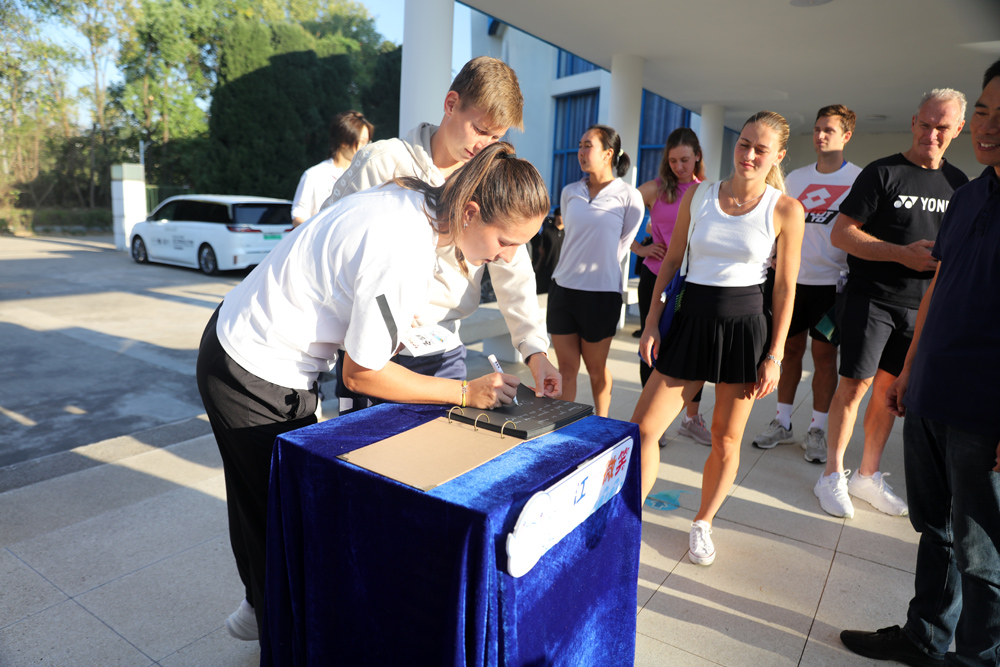
Newsroom
Wuhan Open Tennis Stars Embark on Yangtze Finless Porpoise Conservation Journey

As the Wuhan Open tennis tournament kicked off, players including Daria Kasatkina, Marta Kostyuk, Elise Mertens, Demi Schuurs, and Giuliana Olmos visited the Baiji Dolphinarium on October 4, 2024.(Credit: IHB)
As the Wuhan Open tennis tournament kicked off, players including Daria Kasatkina, Marta Kostyuk, Elise Mertens, Demi Schuurs, and Giuliana Olmos visited the Baiji Dolphinarium at the Institute of Hydrobiology (IHB) of the Chinese Academy of Sciences on October 4, 2024, to participate in the "Preserving the Smile of the Yangtze" public conservation initiative.
In his welcome speech, MIAO Wei, director of IHB, emphasized the institute's long-standing commitment to the protection of the Yangtze finless porpoise. He highlighted the work of the Wuhan Baiji Conservation Foundation, China’s first public welfare organization named after an endangered aquatic species, which focuses on mobilizing public support for the conservation of the porpoise. Miao expressed his hope that the athletes’ interaction with scientists would deepen their understanding of China's conservation efforts and inspire them to share these stories of ecological protection with audiences worldwide.
During the visit, HAO Yujiang, an associate professor at IHB, provided a detailed overview of finless porpoise conservation. Known as the "smile of the Yangtze" for its upturned mouth, the porpoise has faced significant population decline due to pressures from rapid economic development and water-related activities. However, following the implementation of the Yangtze River Protection Strategy and the ten-year fishing ban, the river’s ecosystem has shown remarkable recovery, with the porpoise population achieving a historic rebound.
At the Baiji Dolphinarium, the players experienced hands-on interaction by feeding porpoise calves under the guidance of trainers. In the underwater observation room, they observed the playful behavior of the porpoises and waved to the curious calves peeking through the glass. The athletes were charmed by the endearing creatures and expressed admiration for the work of Chinese scientists. They also voiced their hopes to use the power of tennis to raise global awareness about the conservation of the Yangtze finless porpoise.
At the conclusion of the tour, director MIAO Wei and deputy director XIE Shouqi presented the players with porpoise-themed gifts. The athletes signed memorabilia and left heartfelt messages for the porpoise conservation efforts.
The Wuhan Open’s connection with Yangtze finless porpoise conservation dates back to 2015, with visits to the Baiji Dolphinarium becoming a signature event of the tournament. Through sports and cultural exchanges, the tournament has helped share the story of the porpoise’s protection with the world.
As a keystone species in the Yangtze ecosystem and the last surviving freshwater cetacean native to China, the finless porpoise's conservation success has been recognized as a "beacon of hope" by the international cetacean research community.
The conservation strategy led by IHB has become a global model for balancing river civilization and ecological sustainability. The athletes’ interaction with the porpoise calves has brought renewed energy to conservation efforts, inspiring hope that more people will join in safeguarding the "smile of the Yangtze."

MIAO Wei, director of IHB, presented Elise Mertens with a porpoise-themed gift.(Credit: IHB)

Daria Kasatkina signed her name in the guestbook. (Credit: IHB)

Players from the Wuhan Open took a group photo with volunteers from IHB. (Credit: IHB)